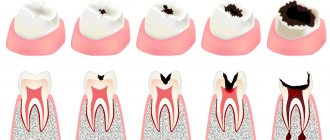Defects appear from tobacco smoke as a result of sedimentation of resins, from high levels of fluoride in the water that the patient constantly drinks. The situation is negatively affected by insufficient hygiene, as a result of which caries develops. Irregular cleaning of the chewing organs leads to the accumulation of soft and hard brown deposits. Such defects cannot be dealt with without the participation of a dentist. Contact your doctor in a timely manner to avoid complications.
Reasons for color change
Have you noticed that the filling on your tooth has darkened? Several factors could have contributed to the color change.
- Consumption of coloring products. A newly placed filling can become darkened by strong tea, black coffee, chocolate, red wine, grapes, and concentrated fruit juices. The composite can also become colored when consuming carrots, beets, blueberries, cherries, and carbonated drinks with dyes.
- Smoking. Tobacco smoke causes resins, plant alkaloids, and organic acids to settle on restored teeth, causing them to acquire a yellowish or brown tint.
- High levels of fluoride in water and food. Drinking low-quality water and foods high in mineral content can cause multiple stains on your teeth.
- Insufficient oral hygiene. If you don't clean your teeth well, stains will remain on them and bacterial plaque will accumulate. This can lead to secondary caries.
Errors during the preparation stages and secondary caries
When a tooth under a filling turns black and hurts, this may be the result of poor-quality endodontic treatment. Go to another clinic and be examined using a microscope. This will make it possible to recognize even microscopic errors in previous therapy. From this, secondary caries often develops. It is provoked by shrinkage of cement that is not placed tightly. At the same time, the size of the lining decreases, which creates cavities between the material and the tissues of the masticatory organ. Bacteria thrive in such holes.
Removing an old filling requires the dentist to thoroughly clean the cavity. However, it happens that blood, organic remains, and pus remain inside the unit. When destroyed, they cause a defect in the chewing organ in the form of brown spots. Leaky application of cement or incomplete removal of pathogenic pulp also leads to problems. Common mistakes made by doctors:
- The dentist may not completely dry the tooth cavity before placing composite cement.
- Laying the material in a thick layer at a time, instead of applying it in small portions.
- Careless polymerization.
- Incomplete cleaning of pathological dentin.
After such mistakes, caries forms again. Patients complain of increased sensitivity of crowns, changes in their shade, mobility of the embedded glue, and bad breath. In this case, therapy is needed. First, the defective material is removed, then the cavity is cleaned, then treated with an antiseptic. Finally, a new composite is installed and polymerized.
Types of darkening of restorations
Most often, fillings on teeth darken evenly. Fresh fillings may become stained in the first hours after placement if you consume coloring products. Old restorations are also subject to uniform discoloration:
- due to the effects of low and high temperatures,
- narrowing or expansion of the filling.
Less commonly, composite restorations darken around the perimeter. This occurs due to the fact that the filling material has not completely filled the carious cavity. Pathogenic microorganisms and food particles penetrate into a small crack, which leads to darkening and destruction of the filling.
Associated symptoms
In addition to blackening of the enamel, other symptoms may develop:
- The appearance of erosions, gouges, black spots or spots on the enamel.
- Unpleasant odor from the mouth.
- Mobility of the filling.
- Pain when pressing, tapping or chewing.
- Inflammatory process in the gums around the filling, bleeding of the mucous membrane, swelling. The appearance of bumps or gumboil in an advanced stage.
Changes in tooth color should not be ignored. This is a clear sign of a pathological process.
Methods for preventing caries under a filling
High-quality prevention of secondary caries involves the elimination of complications at the stage of initial installation of a filling - the doctor must ensure the correct method of caries treatment, antiseptic treatment of the hole for the filling and installation of the filling.
On the patient’s side, the most effective prevention of secondary caries under a filling is maintaining proper oral hygiene, as well as systematic examinations in a dental clinic: a month after the filling is installed and at least 2 times a year thereafter.
A child's fillings fall out of his baby teeth
The destruction of fillings on baby teeth is associated with the following factors:
- Enamel and dentin in children are much weaker than in adults.
- The skills of proper brushing of teeth are not sufficiently developed.
- Frequent dental problems associated with dirty hands.
- Fidgets injure their teeth by falling and chewing hard objects.
- Children love to drink cola. With constant consumption of a drink containing phosphoric acid, teeth are destroyed and fillings fall out.
- Parents mistakenly refuse to install an inlay or crown on a badly damaged tooth for their child; instead, they insist on building it up.
What to do if a child’s baby tooth filling falls out? Re-filling is required. Tooth extraction is not advisable, as problems with bite may arise in the future. Leaving a damaged tooth without a filling is also not worth it. Repeated caries will negatively affect the condition of the rudiments of permanent teeth.
A filling fell out: what to do before visiting a doctor
- Make an appointment with your dentist.
- Brush your teeth twice a day, especially on the damaged side.
- Chew on the opposite side.
- After each meal, use mouthwash or rinse your mouth with warm water. You can use chamomile decoction or an antiseptic (furacilin, chlorhexidine).
- Do not touch the resulting cavity with a toothpick.
- Do not try to seal the “hole” with cotton wool or gum.
- For pain, take Nurofen (can be used for pregnant women and children) or another analgesic.
- There is no need to try to fill the cavity with a fallen filling.
Diagnostics
The task of diagnosis is to determine why the filling material and the dental elements underneath have turned black. Professional techniques will help identify the presence of caries and the extent of damage in order to make a final decision on removal or treatment.
Diagnosis consists of a visual examination, as well as an x-ray examination. If concomitant diseases of the oral cavity are suspected, additional diagnostic methods can be used.
A filling fell out: special reasons for women
In addition to the above factors, the destruction of fillings in women can accelerate for two reasons:
- menopause - due to impaired calcium absorption, bones and teeth lose strength;
- expecting a child - all nutrients are used for the development of the fetus, so pregnant women often lose fillings, and then their teeth very quickly collapse.
The fact that pregnant women cannot have their teeth treated is an unacceptable misconception. On the contrary, expectant mothers need to eliminate all foci of infection, including caries. The anesthetics used do not harm the child, the treatment is completely painless. However, it is advisable to carry out dental treatment in the second trimester of pregnancy.
Why does the tooth turn black?
Crowns help restore the integrity of the dentition and maintain the structure of periodontal tissue. If before prosthetics the color of the unit was natural, and the transformation occurred subsequently, then the reasons for the darkening of the tooth may be
:
- Imperfect processing and unskilled treatment of a decaying tooth before prosthetics.
- Ignoring a crack in a ceramic crown. Especially from the reverse side, when there is no violation of visual aesthetics.
- Formation of a pocket between the gum and crown. Radical caries begins, bacteria and food debris get under the crown.
- The appearance of a gap between the crown and the ledge formed during tooth processing. Why does this happen? Perhaps the impression was taken incorrectly or the technician made an error. Or the patient refused a temporary crown, and minor deformation of the ledge occurred between treatment and installation.
Sometimes a patient has a metal-ceramic crown, and he is worried because of a dark stripe in the root zone of the chewing tooth. It is worth visiting a doctor, but for the most part, the reason is that the frame below is not covered with a sufficient layer of ceramics and over time begins to show through. The integrity of the prosthesis is not threatened. The defect is only aesthetic.
Another point:
the front teeth or molars may be over-prepared, under the gum. Soft tissues may react with recession, part of the enamel between the gum and the denture will be exposed and the process of destruction will begin.
Also the cause may be somatic ailments, metabolic disorders, chronic gastrointestinal diseases.
A filling fell out - how will they treat it?
It all depends on the specific case. Before treatment, the tooth cavity is cleaned with a drill machine to remove any remaining filling material.
- Part of the filling has fallen out - the remaining part is removed and re-sealed.
- A filling with a piece of tooth falls out - they make a filling or install an inlay (more reliable than a regular cement filling). In case of radical destruction of the crown, pins are installed, and then (for greater tooth strength) an artificial crown.
- A filling with a pin has fallen out - if the root is intact, the pins are re-installed into the tooth and covered with a crown. If, after a filling falls out, a tooth breaks (the entire crown part falls off) and the roots are damaged, it is necessary to remove the remains of the tooth and install a prosthesis (bridge or implant).
To minimize the risk of a filling falling out, contact the First Family Clinic of St. Petersburg. Experienced dentists provide high-quality treatment for caries and reconstruct teeth after the filling has been destroyed.
Methods for diagnosing and treating caries under fillings
It is quite difficult to determine the presence of secondary caries in the initial stages, due to the absence of symptomatic and visual manifestations. The disease is diagnosed during a follow-up appointment using diagnostic equipment (hardware diagnostics).
Diagnostics includes two stages:
- Anamnesis and initial examination of the causative tooth in order to detect visible structural changes in hard tissues;
- Hardware diagnostics (physiography) is aimed at detecting hidden changes in the structure of dental tissues.
If a pathology is detected, treatment is prescribed taking into account the individual characteristics of the patient.
When to eat mono after filling?
People who have ever had a filling installed know that you can eat no earlier than two hours later. This time is enough for the material to acquire the required hardness and be well fixed in the tooth crown.
Modern materials differ from classical composites, so the question of whether it is possible to eat after a light filling is relevant. Dentists have different opinions regarding how long after a light filling can be eaten without the risk of damage. Some experts are of the opinion that after a light filling you can eat immediately. This is explained by the properties of photopolymers. The material hardens under the influence of ultraviolet rays, which means that after the procedure is completed, the filling should not be exposed to external influences.
However, the risk is not completely excluded. For complete confidence in the readiness of the material, and most importantly, its reliable fixation in the tooth. For this reason, most experts, when asked “how long not to eat after installing a light filling,” recommend refraining from eating and drinking for at least 2 hours.
What to do if the tooth has darkened
You just need to come to the clinic for a consultation. We will remove the prosthesis and find out the cause of the strange sensations. If the crown has already been removed and a darkened tooth is visible, we will consider options for saving it. First you need to determine the condition of the root and undergo a course of treatment. In the case when it is already destroyed, removal of the remains will be required, followed by implantation.
Is there a healthy root? Then you can install new crowns on your teeth quickly using Cerec technology
.
New technology eliminates errors. This is an opportunity to make ideal dentures and quickly cover a tooth with a crown. Steps:
- The scanner determines the characteristics of the damage; adjacent and opposite units and closed rows are scanned.
- The program combines information and creates a 3D model of inlays and crowns, taking into account anatomical features. The computer calculates the dimensions of the prostheses and the nuances of their shape.
- Even before the process begins, the patient can see the result. We select the shade - each change is agreed with the patient.
- A special machine makes an inlay and a crown from a blank.
- During fitting, it is rare, but the need for correction arises. In most cases, these are nuances of the shade of the crown. But a new copy according to the template is made within 15 minutes
. - The crown or inlay fits tightly to the remaining parts of the tooth, preventing pathogenic microflora from entering the tissue.
The process takes only 1.5 hours and allows you to save a darkening tooth. This technology is the best that has been created in dental practice. Allows you to quickly and accurately produce single versions of crowns for teeth or bridges from metal-free materials - ceramics and zirconium dioxide. We will discuss the nuances of your particular case during your visit; the cost of installing a crown on a tooth starts from 27,900 rubles. There are promotions and special offers. Keep your teeth healthy and your body will thank you.











